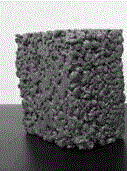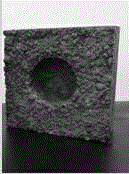Functional porous cement based composite material and preparation method thereof
A composite material and cement-based technology, applied in the field of material science and engineering, can solve the problems of difficult large-scale application and high cost of ceramic membranes, and achieve the effects of easy acquisition, low cost and simple preparation process
- Summary
- Abstract
- Description
- Claims
- Application Information
AI Technical Summary
Problems solved by technology
Method used
Image
Examples
Embodiment 1
[0036] The preparation of functional porous cement-based composite material, the method is as follows:
[0037] 1) Preparation of graphite oxide: take 5g of graphite and 5g of sodium nitrate and place in a three-necked flask equipped with 160mL98wt% concentrated sulfuric acid, stir and react at a constant temperature in an ice bath for 1h, then continue to add 23g of potassium permanganate slowly in portions (note Keep the temperature), and keep stirring for 2h, then place it at room temperature for a week, then dilute with 500mL of 5% sulfuric acid solution (note that the temperature will rise rapidly), stir for 2h, and finally add 15mL of 30% hydrogen peroxide to reduce the remaining potassium permanganate for 2h. After repeated washing with water and centrifugation for several times until it becomes neutral, it is then vacuum-dried to obtain graphite oxide.
[0038] 2) Preparation of titanium dioxide colloidal suspension solution: firstly take 100mL tetrabutyl titanate and ...
Embodiment 2
[0043] Preparation of Undoped Porous Cementitious Composites:
[0044] 1) Preparation of cement composite slurry: Weigh 350g of water, 700g of cement, and 600g of ceramsite (particle size after crushing: 0.5-5mm) and mix them with a mixer for 3 minutes to obtain a cement composite slurry.
[0045] 2) Forming and maintenance of porous cement-based composite materials: After injecting the cement composite slurry in the above 1) into the mold (150×150×150mm) and flattening and vibrating, in order to facilitate the algae separation test, pre-prepared in the center of the upper surface. Press out a small pit with a depth of about 2cm, and leave the mold for 24 hours. The demoulded samples were placed in the laboratory for 28 days under natural conditions to obtain an undoped porous cement-based composite material.
Embodiment 3
[0047] The preparation of functional porous cement-based composite material, the method is as follows:
[0048] 1) Preparation of graphite oxide solution: Weigh 5g of flake graphite and 5g of sodium nitrate in a three-necked flask filled with 160mL98% concentrated sulfuric acid, stir and react at a constant temperature in an ice bath for 1h, then continue to add 23g of potassium permanganate slowly in portions , and kept stirring for 2 hours, then left it at room temperature for a week, then diluted it with 500 mL of 5% sulfuric acid solution and stirred for 2 hours, and finally added 15 mL of 30% hydrogen peroxide to reduce the remaining potassium permanganate for 2 hours. After repeated washing with water and centrifugation for several times until it becomes neutral, it is then vacuum-dried to obtain graphite oxide.
[0049] 2) Preparation of titanium dioxide colloidal suspension solution: Firstly, 20 mL of tetrabutyl titanate and 5 mL of acetylacetone were dissolved in 40 m...
PUM
| Property | Measurement | Unit |
|---|---|---|
| particle diameter | aaaaa | aaaaa |
Abstract
Description
Claims
Application Information
 Login to View More
Login to View More - R&D
- Intellectual Property
- Life Sciences
- Materials
- Tech Scout
- Unparalleled Data Quality
- Higher Quality Content
- 60% Fewer Hallucinations
Browse by: Latest US Patents, China's latest patents, Technical Efficacy Thesaurus, Application Domain, Technology Topic, Popular Technical Reports.
© 2025 PatSnap. All rights reserved.Legal|Privacy policy|Modern Slavery Act Transparency Statement|Sitemap|About US| Contact US: help@patsnap.com



